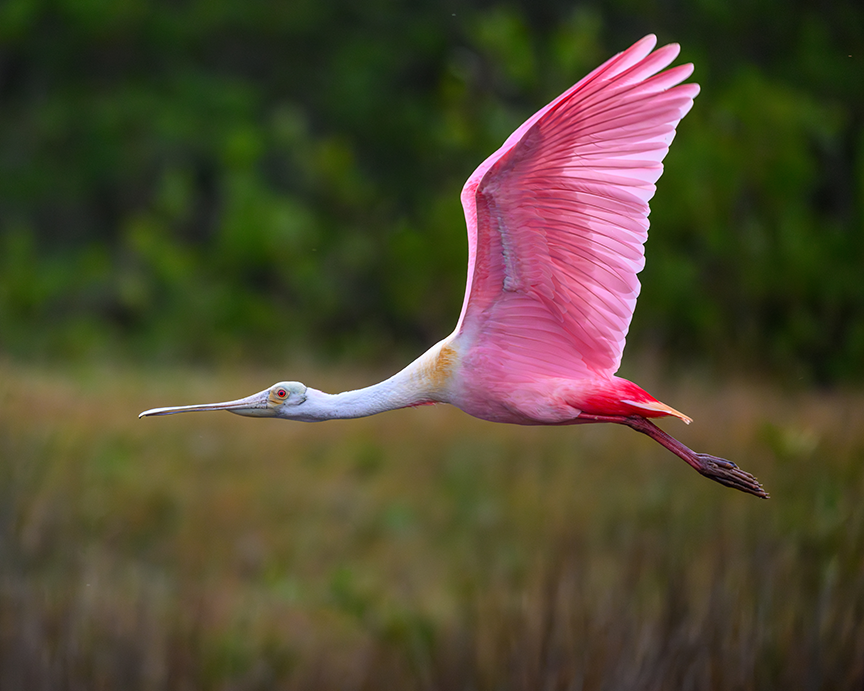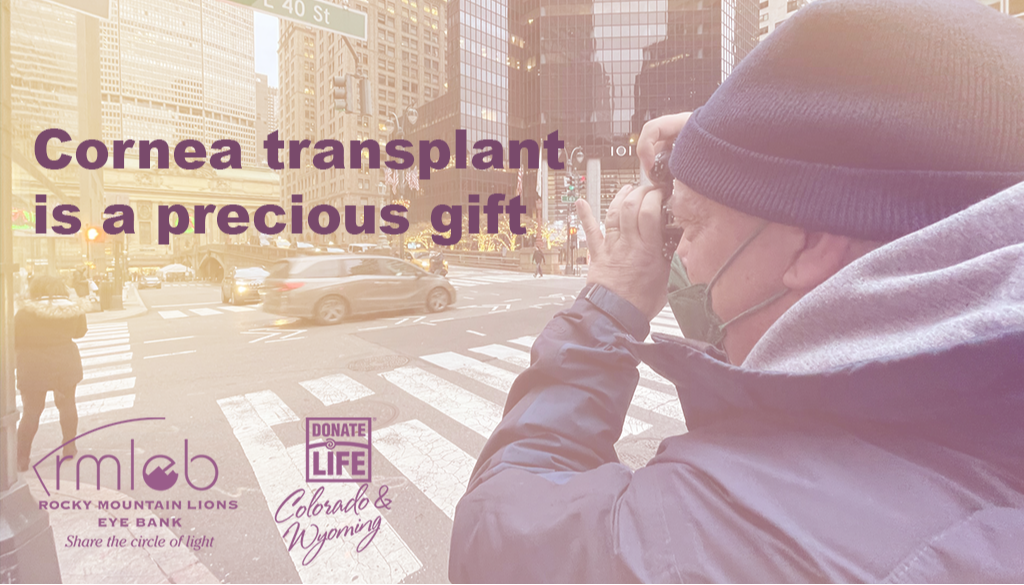Cornea transplant is a precious gift
Cornea recipient shares what he can see through photographs
By Rae Price - July 24, 2024
Dean Allman had vision problems from a young age but didn’t realize it until his sister went to the optometrist and was prescribed glasses. When he tried them on and commented that he could see better, his parents took him to the optometrist.
“I’ve been wearing corrective lenses ever since,” he said.
Through the years, his vision continued to worsen due to a condition called Keratoconus. Doctors prescribed glasses and contact lenses, but nothing was truly effective. Doctors also tried a procedure called Corneal Cross Linking (CXL), a surgery to treat a weakened or warped cornea. Finally, Allman said, “I was really down to my last resort in terms of needing the transplant and had the surgery on my right eye in 2020.” According to his doctors, Allman said he will likely need a transplant in his left eye as well.
Lifelong love of photography
Now, with vision that usually tests 20/20 or better in his right eye, Allman can live a full life and pursue his love of nature and photography.
He grew up in Pittsburg, Penn, and his interest in photography was sparked at the age of 14 when his dad gave him a camera prior to leaving for a national Boy Scout jamboree in Idaho. Enthralled with the rock formations and colors, he captured many of the images on film. Upon having the film developed, Dean said his dad commented that they were “pictures of rocks.” He noted his response was, “‘Yeah Dad, but they are the coolest rocks I’ve ever seen!’ I’m still entranced with shapes, angles, light and shadows. That 14-year-old boy is still here.”
Later, he received his first 35mm camera from his then girlfriend, who he said had watched him looking at the flyers in the newspaper from a local camera store. When he came home from work one night, there was a gift on the table for him. When he opened it, he found a Minolta SRT 210; he smiled and said, “I think I proposed to her that night.” He said she remains his strongest supporter.
Sharing through photography
.jpg)

Photos by Dean Allman, sandhill crane on top and roseate spoonbill on bottom
Allman was given the gift of sight in the form of his cornea transplant and is delighted to share his gift through his photography. The opportunity to show his work through the Rocky Mountain Lions Eye Bank’s Circle of Light Photo Project is gratifying, not just because it celebrates his restored vision, but it also showcases his love of nature.
“I think what’s great about it is that the photos I submitted and that are displayed are from nature. To be able to see the roseate spoonbill in flight, or my favorite, the sandhill crane in flight, I dearly love those animals. I feel a connection in some way, and to be able to express that love and show that for other people to see and appreciated makes me feel pretty good.”
Unconditional gift of sight
Talking about his cornea donor and their family can be hard for Allman without becoming emotional.
“I have an incredible sense of gratitude that I’ve been given through the graciousness of somebody else who I don’t know, the gift of vision again; and to be able to express myself in my work, to be able to interact with my family; to be able to spend time with my friends; to be able to see and experience the world is a gift.” He said in yoga, the class talks about being present, and “this allows me to be present.”
Allman is reflective, thinking that someone was open to donation, knowing their gift would be truly an unconditional benefit for somebody that they didn’t know. “That’s just amazing to me,” he said. “It speaks to a higher level of humanity, and I think it’s something that we can all aspire to in terms of how we are with one another.”
Thinking about what to say to somebody who may be hesitant to register as an eye, organ and tissue donor, Allman would tell them that saying “yes” can make a difference.
“The reality is, it really does help people a great deal. It can help one person in this world, and if that’s all we can do sometimes in life, that’s a good thing,” he said.
Gratitude for eye tissue donors
Reflecting on his gratitude to the cornea donor and the donor’s family, Allman said, “Through the graciousness of that individual, their contribution helped somebody live on in a way that they probably could have never predicted or anticipated.”
RMLEB helps facilitate communication between cornea recipients and donor families, acting as an intermediary to help maintain confidentiality. Allman said he wrote to the cornea donor’s family but has not received a response.
“I’m OK with that because I think it’s highly personal in terms of the decisions people make around organ and tissue donation, and that’s appropriate. I wanted them to know how grateful I was, so I was glad I wrote to them.” He added, “Through the graciousness of that individual donor, their contribution helped somebody live on in a way that they probably could never have predicted or anticipated.”
“I am sometimes amazed at how much this has actually impacted my life. That something that was a hardship has been taken care of and has opened things up for me in ways that I could have never anticipated. I’m very grateful for that,” Allman concluded.
Go Back “I’ve been wearing corrective lenses ever since,” he said.
Through the years, his vision continued to worsen due to a condition called Keratoconus. Doctors prescribed glasses and contact lenses, but nothing was truly effective. Doctors also tried a procedure called Corneal Cross Linking (CXL), a surgery to treat a weakened or warped cornea. Finally, Allman said, “I was really down to my last resort in terms of needing the transplant and had the surgery on my right eye in 2020.” According to his doctors, Allman said he will likely need a transplant in his left eye as well.
Lifelong love of photography
Now, with vision that usually tests 20/20 or better in his right eye, Allman can live a full life and pursue his love of nature and photography.
He grew up in Pittsburg, Penn, and his interest in photography was sparked at the age of 14 when his dad gave him a camera prior to leaving for a national Boy Scout jamboree in Idaho. Enthralled with the rock formations and colors, he captured many of the images on film. Upon having the film developed, Dean said his dad commented that they were “pictures of rocks.” He noted his response was, “‘Yeah Dad, but they are the coolest rocks I’ve ever seen!’ I’m still entranced with shapes, angles, light and shadows. That 14-year-old boy is still here.”
Later, he received his first 35mm camera from his then girlfriend, who he said had watched him looking at the flyers in the newspaper from a local camera store. When he came home from work one night, there was a gift on the table for him. When he opened it, he found a Minolta SRT 210; he smiled and said, “I think I proposed to her that night.” He said she remains his strongest supporter.
Sharing through photography
.jpg)

Photos by Dean Allman, sandhill crane on top and roseate spoonbill on bottom
Allman was given the gift of sight in the form of his cornea transplant and is delighted to share his gift through his photography. The opportunity to show his work through the Rocky Mountain Lions Eye Bank’s Circle of Light Photo Project is gratifying, not just because it celebrates his restored vision, but it also showcases his love of nature.
“I think what’s great about it is that the photos I submitted and that are displayed are from nature. To be able to see the roseate spoonbill in flight, or my favorite, the sandhill crane in flight, I dearly love those animals. I feel a connection in some way, and to be able to express that love and show that for other people to see and appreciated makes me feel pretty good.”
Unconditional gift of sight
Talking about his cornea donor and their family can be hard for Allman without becoming emotional.
“I have an incredible sense of gratitude that I’ve been given through the graciousness of somebody else who I don’t know, the gift of vision again; and to be able to express myself in my work, to be able to interact with my family; to be able to spend time with my friends; to be able to see and experience the world is a gift.” He said in yoga, the class talks about being present, and “this allows me to be present.”
Allman is reflective, thinking that someone was open to donation, knowing their gift would be truly an unconditional benefit for somebody that they didn’t know. “That’s just amazing to me,” he said. “It speaks to a higher level of humanity, and I think it’s something that we can all aspire to in terms of how we are with one another.”
Thinking about what to say to somebody who may be hesitant to register as an eye, organ and tissue donor, Allman would tell them that saying “yes” can make a difference.
“The reality is, it really does help people a great deal. It can help one person in this world, and if that’s all we can do sometimes in life, that’s a good thing,” he said.
Gratitude for eye tissue donors
Reflecting on his gratitude to the cornea donor and the donor’s family, Allman said, “Through the graciousness of that individual, their contribution helped somebody live on in a way that they probably could have never predicted or anticipated.”
RMLEB helps facilitate communication between cornea recipients and donor families, acting as an intermediary to help maintain confidentiality. Allman said he wrote to the cornea donor’s family but has not received a response.
“I’m OK with that because I think it’s highly personal in terms of the decisions people make around organ and tissue donation, and that’s appropriate. I wanted them to know how grateful I was, so I was glad I wrote to them.” He added, “Through the graciousness of that individual donor, their contribution helped somebody live on in a way that they probably could never have predicted or anticipated.”
“I am sometimes amazed at how much this has actually impacted my life. That something that was a hardship has been taken care of and has opened things up for me in ways that I could have never anticipated. I’m very grateful for that,” Allman concluded.
